Contents
The Global Pig Population and Its Origins
Across the world, approximately 760M pigs are bred annually, mainly for meat. From these domesticated pigs, roughly 120M metric tons of pork is produced per year, fulfilling the global market for protein needs. (Ref1,Ref2)

Domestic pigs are known as “Sus scrofa domesticus“, an offspring of the wild boar, Sus scrofa. Wild boars have been present since the “Pleistocene period“, but the exact timeline of their domestication remains unclear. However, it is assessed that humans started domesticating pigs around 10,000 years back, incorporating them into homes and then farms for their utility and meat.
Pigs – Even-Toed Ungulates and Versatile Omnivores
Pigs belong to the group of “even-toed ungulates“, this category includes animals such as goats, cows, and camels. While these animals share structural similarities. But, pigs are omnivores capable of eat both meat & plant based foods. Unlike herbivores like cows and goats, pigs can chew the digest bones efficiently.

An example of pigs’ omnivorous nature and ability to consume even bones. In a shocking incident in the U.S., A pig farmer suffered a fatal heart attack while feeding pigs on his farm. When he was not found for three days, his friends arrived at the farm, only to discover that most of his body had been eaten by the pigs, leaving only a few bones. This incident highlights the adaptability of pigs’ diet and their capacity to survive in dire situations by eating available resources.
The Structure and Benefits of a Pig’s Nose
The noses of pigs might look peculiar. But it serves an essential purpose. Shaped similarly to the trunk of an elephant, a pig’s nose is their strength. It helps the pig smell and discover food, actually when buried underground, and is also adept at digging it out.
For instance, pigs are often used to hunt for truffles, the world’s costliest mushrooms. Their sharp sense of smell allows them to detect truffles buried as deep as three feet. Trained pigs assist hunters in finding and digging out these treasures. Interestingly, a movie called “The Pig“, starring Nicholas Cage, is based on the truffle-hunting process and the role of these specially trained pigs.
The Truth Behind Pigs Seeming Dirty and Smelly
When people think of pigs, the first image is often one of filth and a terrible stench. This is because domestic pigs are commonly seen living in gutters and wallowing in their own waste. However, wild boars, their close relatives, are entirely different. Wild boars maintain a clean lifestyle by defecating far away from their habitats. The stark difference in behavior arises from domestication. When humans started keeping pigs in confined spaces, the animals adapted to their limited environments.

Another reason for their love of slush is physiological. Pigs lack sweat glands, meaning they cannot release body heat through sweating. To cool themselves down, pigs roll in mud and slush a trait they share with animals like elephants, rhinoceroses, and hippopotamuses. The only difference is that pigs roll far more frequently, making it an essential survival mechanism rather than just a habit.
The Reason Behind Pigs Rubbing Each Other’s Noses

If you observe pigs frolicking in the mud, you might notice them rubbing their noses together, a behavior known as rooting. This is because pigs are highly social animals. They use such actions to strengthen their bonds and maintain their relationships within the group. Their social nature is evident from a young age. As piglets, they feed close to their mother and siblings, forming an intimate connection through constant proximity. This sense of closeness remains a vital part of their behavior even as they grow into adult pigs, often lying together to reaffirm their bond.
The Secret Behind the Curious Behavior of Pig’s Teat Order
When drinking milk, piglets exhibit an intriguing behavior called Teat order. Each piglet selects a specific teat on its mother and continues to feed from the same one consistently, much like how students often prefer sitting in the same spot in a classroom. Interestingly, the teats near the mother’s front legs are considered prime spots, and the piglets feeding there are often deemed dominant.
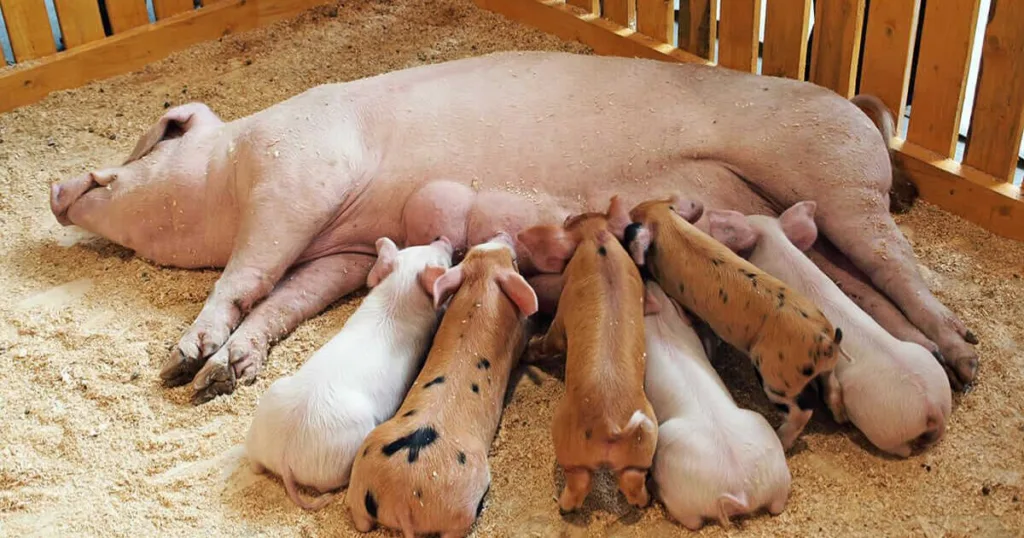
The mother pig plays an active role in this dynamic. She changes her position frequently, disrupting the established teat order and creating fresh competition among the piglets. In this process, the piglet that successfully reclaims its preferred teat or secures a prime spot emerges as the most dominant in the group, reflecting its strength and adaptability.
The Fascinating Ways Pigs Communicate
Pigs are surprisingly expressive creatures, with about 20 different sounds used to convey the message to each other. An example is the mother pig, which makes soft sounds resembling a lullaby to calm her piglets while they feed. This sound is not due to pain but serves to relax the young ones. Beyond vocalizations, pigs also rely on body language to convey emotions and maintain social interactions, showcasing their complex communication skills.
The Nest-Building Habits of Pigs
Just like birds, pigs build nests, particularly when they are close to giving birth. This behavior is most evident in wild boars, which prepare a comfortable bed of twigs and dried leaves for the birthing process. Domesticated pigs, however, rarely exhibit this natural trait due to the limited space in farm environments. Nonetheless, the instinct to create a safe and comfortable space for their offspring remains deeply ingrained in pigs.
The Average Number of Piglets Per Birth & Life Expectancy of Pigs
Pigs are prolific breeders. In a single labor, a pig can give birth to around 10 piglets and may become pregnant twice a year, resulting in up to 20 piglets yearly. The average lifespan of a pig ranges between 10 – 20 years, based on its atmosphere and care.
The oldest pig ever Baby Jane, born on February 1, 1998, died on September 10, 2021, at the age of 23 years, 7 months, and 9 days in Mundelein, Illinois, USA, and her Guinness World Record was verified on April 19, 2021, as the oldest pig in captivity
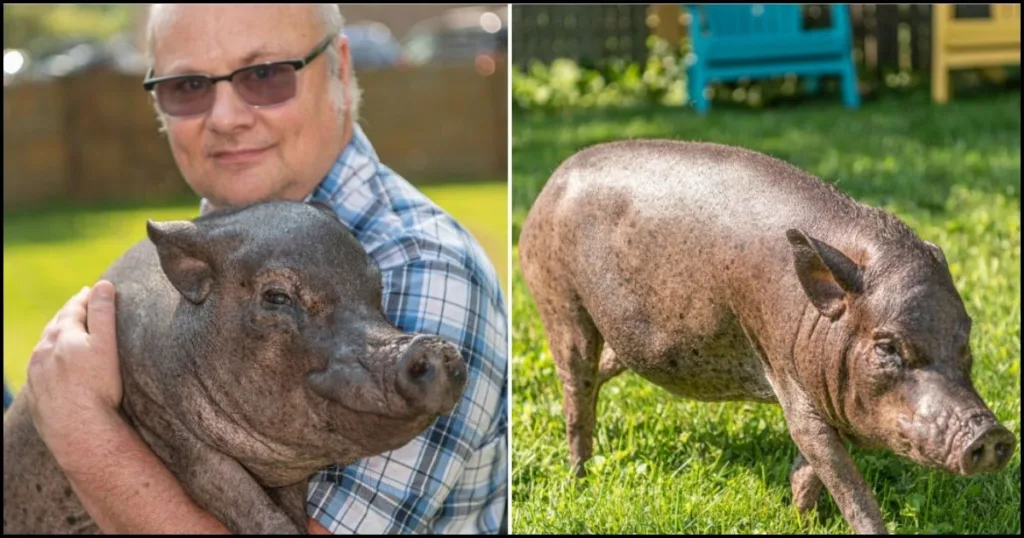
The Maximum Size Pigs Can Reach
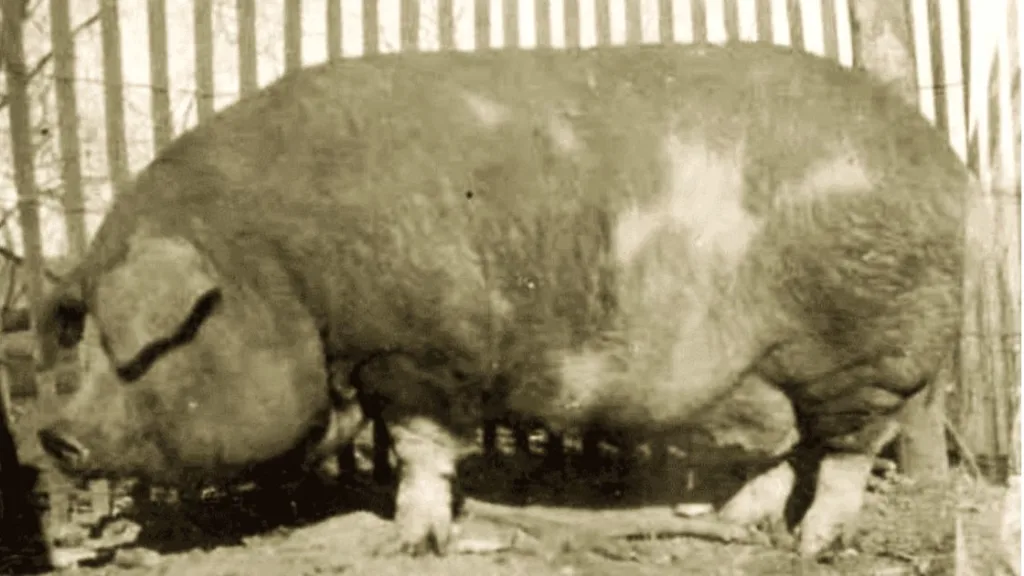
The size and weight of a pig vary significantly based on its breed, diet, and habitat. Most pigs can grow more than 50 kilograms, especially, the domestic meat breeds commonly grow to weigh between 140 kg and 300 kg.
The heaviest pig ever recorded in the state of Tennessee was a Poland China breed that weighed 1,158 kilograms in 1933
There are smaller breeds like teacup pigs, which were specifically developed to be kept as pets. On the other hand, unique breeds like the Mangalica pig, known for its sheep-like fur, highlight the diversity within the pig family. Although Mangalica pigs resemble sheep, their fur is not used commercially. Wild boars, a subspecies of pigs, also add to this diversity, with 16 recognized subspecies found worldwide.
The Intelligence of Pigs
Finally, experts allocated the 5th rank to the pig as the most intelligent animal species, surpassing dogs in cognitive abilities. Their memory is remarkable, they can remember the location of objects and even check those spots later.
If pigs were able to focus, studies suggest they could learn to play video games. In terms of intelligence, pigs are smarter than a 3-year-old human child and can outperform children in certain tasks, highlighting their advanced cognitive skills.
Are Pigs Truly Treacherous Animals?
Pigs share certain traits with humans, including intelligence, and some less favorable characteristics, like cunning behavior. They can display unfaithfulness even towards their own kind.
This was demonstrated in an experiment where two pigs were involved. One pig was shown a hidden food source. The next day, both pigs were released together. The pig with prior knowledge headed straight to the food but noticed it was being followed by the other pig. In a display of cunning behavior, it changed direction, misleading the other pig. Once it had successfully distracted its companion, the first pig returned to the hidden food to eat alone. This behavior shows how pigs can use their intelligence for self-serving purposes.
The Noisy Nature of Pigs and Their Use as Suicide Troops in War
Pigs can produce incredibly loud sounds, with their oinks estimating up to 115 decibels. To put this into perspective, humans can struggle to tolerate sounds above 120 decibels. This makes the volume of a pig’s vocalizations almost unbearable for human ears, showcasing their powerful voice. The loud and piercing screams of pigs made them an unusual but effective weapon in ancient warfare. To scatter and frighten elephant troops, pigs were used as a psychological tactic.
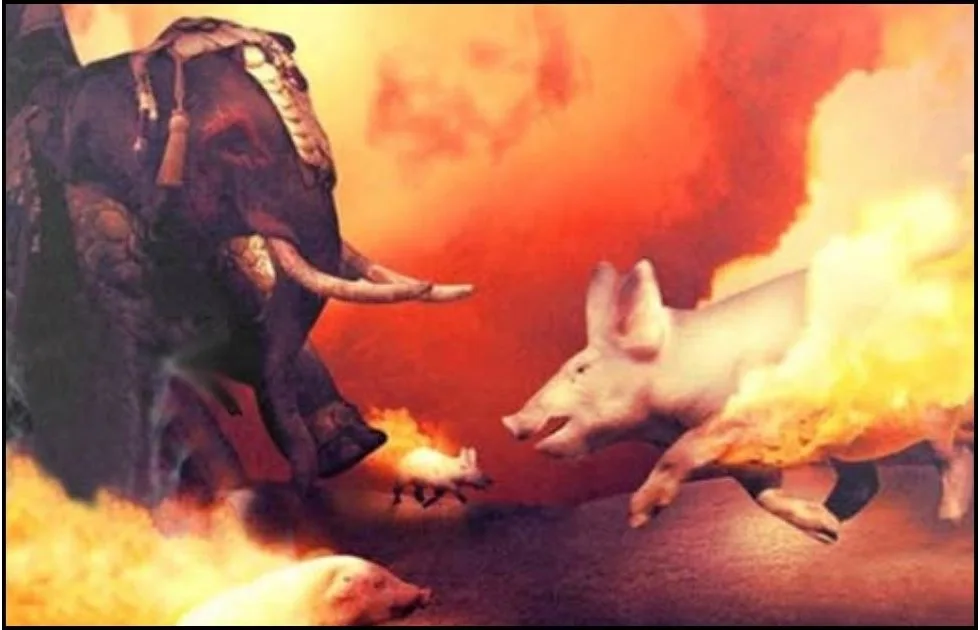
The story behind War Pig: A notable instance occurred in 400 BC during the Battle of Megara. Spartans waged war against Athens, where they poured oil on pigs, set them on fire, and released them towards the enemy. The burning pigs screamed in pain, creating chaos and terror that forced the Athens troops to flee. While often referred to as “suicide troops,” this practice was a horrific act of brutality rather than voluntary sacrifice by the animals.
How Long Do Pig Sleep?
Pigs have sleeping habits significantly parallel to humans, sleeping for about 8 hours a day. Like humans, they experience dreams during sleep, indicating a level of cognitive involvement even in their resting state
Here you can find “Why We Dream, the Purpose of Dreams, and Interesting Facts About the Meaning of Dreams.”
The Reason Pigs Are Used in Experiments
Pigs are often used in medical experiments due to the close similarity of their body structure to that of humans. This similarity makes them ideal for studying diseases and potential treatments. Research on deadly diseases and their cures has often involved pigs. (Ref)
For example, recent advancements included the transplantation of a pig’s heart into a human patient, (Both cases were recorded in 2022 & 2023) though the strategy finally did not succeed. However, this field shows great assurance, with the potential for pigs to be bred for organ donation in the future. While this prospect raises ethical questions, it could revolutionize organ transplantation.

Case 01 (2022): David Bennett, a 57-year-old handyman, had received the genetically modified pig heart during a last-ditch operation to save his life at the University of Maryland Medical Center on Jan. 7. He died on 8 March. (Ref)
Case 02 (2023): Lawrence Faucette, 58, was suffering from terminal heart disease and received a heart transplant from a genetically altered pig on 20 September. He died on 30 October. (Ref)
The Risk of Disease &Transmission from Pigs to Humans
The physical similarities between pigs & humans not only aid medical research but also improve the risk of zoonotic diseases. The 2009 swine flu pandemic (H1N1 flu pandemic) is a prime example. This viral infection, originally common in pigs, mutated and spread to humans, shaking the world much like the recent COVID-19 pandemic. The close biological link between pigs and humans makes such disease transmissions more likely.
The Cultural Significance of Pigs
Despite being seen as dirty animals in many contexts, pigs hold significant cultural importance in various traditions.
For Instance, in Hindu mythology “The Varaha Avatar” an incarnation of Lord Vishnu, is described as a boar, indicating divine intervention. Similarly, in Chinese culture, pigs are associated with wealth, fertility, and birth. The Chinese zodiac also honors pigs with a dedicated year in their calendar, further emphasizing their cultural value.
Why Is It Called a Piggy Bank?
The term “piggy bank” has an interesting origin. In medieval Europe, metal was expensive, and people used a type of inexpensive clay called “pygg” to create household vessels, including money boxes. Over time, these “pygg” money boxes were crafted into the shape of pigs, eventually leading to the name “piggy bank.”
Though the connection lacks definitive documentation, the symbolism of pigs as prosperity and growth likely influenced this practice. In Germany, pigs are seen as symbols of good fortune and wealth. Germans even have a saying, “I got a pig,” (I had luck) to signify a stroke of good luck. This belief further solidified the association of pigs with savings and prosperity. (Ref)
Negative Symbolism of Pigs in practice

While pigs are often viewed as symbols of prosperity, they have also been used negatively in Europe & America, pigs have been portrayed as representations of greed & corruption. For example, pigs were once used to symbolize blood-sucking capitalists exploiting laborers. In America, they have similarly been linked with corrupt practices, tarnishing their image in certain circles.
Pigs in Pop Culture
Pigs have an important place not only in many cultures but also in popular culture. Further showcasing the enduring presence of pigs in entertainment.
Some Iconic Characters:
- Pumbaa – From The Lion King
- Miss Piggy – A star from The Muppet Show
- Babe – From Babe
- Peppa Pig – From the series Peppa Pig
- Spider-Ham (Peter Porker) – A piggy version of Spider-Man from Marvel Comics.
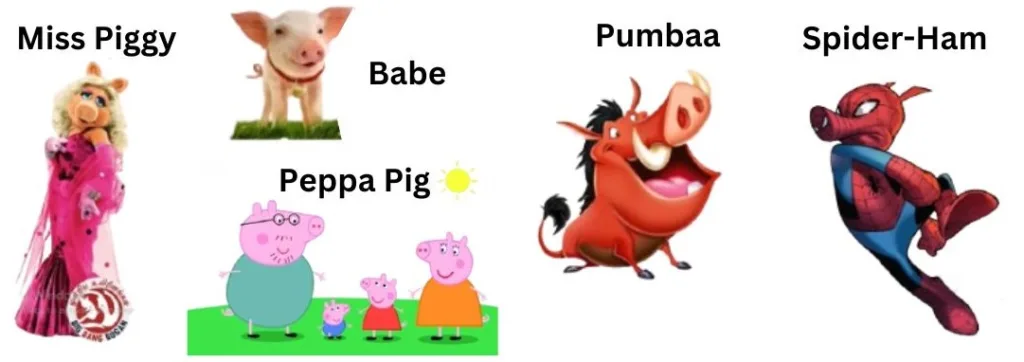
Why Do Pigs Eat feces?
The habit of pigs eating faecal matter might seem undesirable, but there is a scientific explanation for this. While humans view faeces as offensive, many animals see it as a source of nutrition. Faeces often contain water, good bacteria, undigested food, and nutrients. Animals sometimes consume it when they are in need of these nutrients, especially when food is insufficient.
Pigs typically resort to eating waste only when they are extremely hungry or malnourished. Well-fed pigs, such as those raised on farms, do not exhibit this behavior. It is a survival strategy, not a preference, rooted in their need for sustenance during times of scarcity.
How Humans Utilized Pigs’ feces-Eating Habit – The piggy toilet concept

Humans have even found ways to utilize pigs’ ability to consume waste. One such invention is the “piggy toilet.” This system places a human toilet above a pigsty, allowing pigs to consume the waste that drops down. By doing so, pigs grow and thrive while reducing the amount of waste that would otherwise require disposal. This method demonstrates how humans have leveraged pigs’ natural behaviors for practical purposes, albeit in unconventional ways.
Finally, a fun fact for you about pigs – Due to the unique anatomical structure of their necks & spines, pigs are physically unable to look up at the sky. This intriguing limitation is a result of the way their bodies are built, making it one of the rare tasks they simply cannot do.
Here you can find, The Truth Why Pork is Haram in Islam – The Untold Story of Pig in Islam
FAQ
What is the deeper meaning of the movie pig?
In a world frequently observed by cynicism and self-interest, Pig is a story that emphasizes recognizing the humanity of each other. While it may seem like a tale about a man searching for his stolen pig, it is, at its core, a character study of a broken, forgotten man rediscovering himself & instructing others to do the same.
Is the movie Pig a true story?
No, but the story was motivated by a real-life interpretation of “truffle hunters” who stay up at night, armed with shotguns, to defend their environment from competitors.
Is watching Peppa Pig haram?
Criticisms of Peppa Pig and other pig related cultural scope are not based on Islamic instructions. The prohibition is clear to eating pork only, not the presence or description of pigs.
Which is more populous – wild pigs or domestic pigs?
Domestic pigs are considerably higher than wild pigs. The global population of domestic pigs are higher due to their role in farming & food production, while wild pigs are limited by natural habitats & ecological factors. Especially, they are constantly subject to control & hunted for the potential damage to crops and ecosystems.
